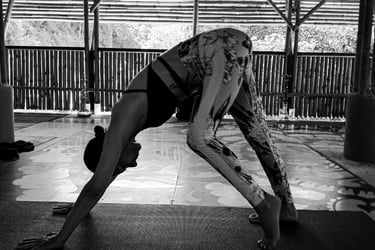How is Yoga a Mind-Body Practice?
While the physical body is obvious - observable and measurable - the mind remains elusive. The precise definition of the mind is still debated, though there is broad agreement that it plays a central role in human life as the seat of consciousness, emotions, thoughts, and our sense of personal identity. Recent advances in neuroscience and research on body language suggest that some of these processes have observable outcomes in the physical world.
In the philosophies of Ayurveda, Yoga, and Tantra, a human being is viewed as Jiva - a physical being (gross body) whose actions are shaped by accumulated feedback (subtle body) but rooted in an innate intuitive sense (causal body).
Consider, for example, a chair. Like a human, it has a physical form - wood, metal, or other materials - that is tangible, measurable, and functional. A chair’s design and craftsmanship reflect the accumulated knowledge and skill of its maker. This 'style' or design could be thought of as its subtle body, imbuing the chair with cultural or aesthetic value, lending it an essential character. Yet, beyond these elements, the chair remains static. Even a motorised chair depends on the driver’s knowledge and skill to move and function effectively.
What the chair lacks is the intuitive seed that drives conscious action and personal evolution. Unlike a human, the chair does not possess inner awareness or consciousness. It cannot act or evolve based on experiences. While it can be passed through time or altered, it lacks the essence that would enable it to respond to its environment or grow from experience.
In yoga philosophy, a human being is understood as comprising three components, often referred to as a hierarchy of bodies:


Yoga is often described as a “mind-body” practice. The compound word suggests a single meaning; a concept beyond the literal understanding of the mind (‘software’) and body (‘hardware’).
Physical Body (Sthula Sharira): The gross, material body that interacts with the physical world, perceivable through the senses.
Subtle Body (Sukshma Sharira): The more ethereal body, which includes the mind, energy, and intellect. This body influences our thoughts, emotions, and breath. This is the body used for feeling and sensing.
Causal Body (Karana Sharira): The most subtle layer, linked to our deepest unconsciousness or the seed of our existence. It carries the impressions from past experiences, shaping our future actions.
What does this have to do with yoga poses?
The physical practice of yoga poses, of course, benefits us physically in terms of flexibility, strength, endurance, etc. All these contribute to the prevention and management of diseases such as cardiovascular disease, hypertension, diabetes, arthritis, and more, besides bolstering our immune system.
But well-being is about more than just physical health. While there’s no single definition of well-being, many agree that it includes emotional and psychological dimensions too.
In yoga philosophy, the constituents of Jiva (our physical, subtle, and causal bodies) are linked together with prana, or life energy. In the context of yoga practice, this prana is accessed and regulated through the breath.
Breathing not only sustains the physical body but also impacts the subtle body, which includes our thoughts, emotions, and energy. This is where the breath connects the physical and the subtle - just as modern science reveals how breathing influences the nervous system and affects our emotional states.
Similarly, neuroscience explores how the body and emotions shape the sense of Self. Research into the emotional brain (limbic system) shows how emotions influence our personal identity and reactions, echoing the role of the subtle body in yoga. The concept of the embodied Self-the way our bodily awareness influences our sense of existence-can be seen as a parallel to the deeper aspects of the causal body. Both views highlight how bodily feedback and internal sensations help realise our core sense of who we are.
So when thinking of yoga as a mind-body practice, we can view it through these connections: the breath influences our nervous system, our emotions shape our identity, and both are integral to our overall well-being.
More Insights
